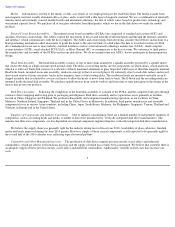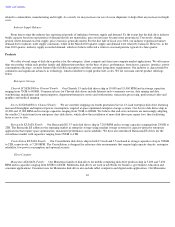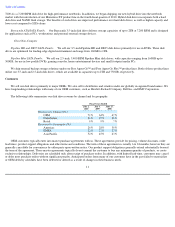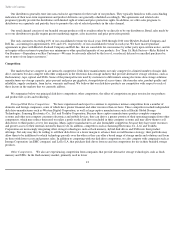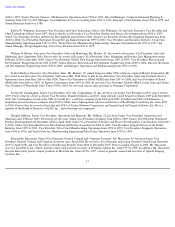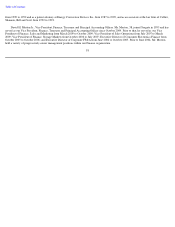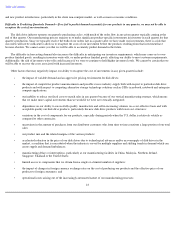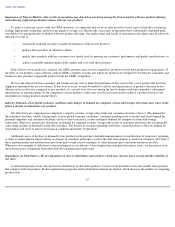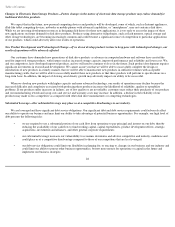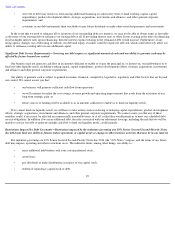Seagate 2009 Annual Report Download - page 21
Download and view the complete annual report
Please find page 21 of the 2009 Seagate annual report below. You can navigate through the pages in the report by either clicking on the pages listed below, or by using the keyword search tool below to find specific information within the annual report.
Table of Contents
ITEM 1A. RISK FACTORS
Risks Related to our Business
Current Macroeconomic Conditions—The recent downturn in the macroeconomic environment has, and may continue to, negatively impact
our results of operations.
The recent downturn in global macroeconomic conditions, particularly in Europe, has had a significant effect on the disk drive industry as a
whole and the results of our operations. Due to the on-
going uncertainty about current macroeconomic conditions, we believe our customers may
postpone spending in response to tighter credit, increasing level of unemployment, negative financial news and/or declines in income or asset
values, which could have a material adverse effect on the demand for our products. Other factors that could influence demand include conditions
in the residential real estate and mortgage markets, labor and healthcare costs, access to credit, consumer confidence and other macroeconomic
factors affecting consumer spending behavior. These and other economic factors could have a material adverse effect on demand for our
products and on our financial condition and operating results.
In addition, the capital and credit markets continue to experience some measure of volatility and disruption, resulting in a tightening in the
credit markets, a low level of liquidity in many financial markets and reduced stability in fixed income, credit, currency and equity markets.
There could be a number of follow-on effects from the credit crisis on our business, including the insolvency of key suppliers resulting in
product delays and the inability of customers to obtain credit to finance purchases of our products.
Competition—
Our industry is highly competitive and our products have experienced and will continue to experience significant price erosion
and market share variability.
The disk drive industry is intensely competitive and vendors typically experience substantial price erosion over the life of a product. Our
competitors have historically offered existing products at lower prices as part of a strategy to gain or retain market share and customers, and we
expect these practices to continue. We will need to continually reduce our prices for existing products to retain our market share, which could
adversely affect our results of operations.
The pricing environment in the first nine months of our 2010 fiscal year was relatively stable owing in part to a favorable supply/demand
balance, though in the June 2010 quarter price erosion returned to seasonal patterns typical of a June quarter. We believe price erosion and
market share variability will continue, as the industry engages in aggressive pricing actions targeted to shift customer demand to offset lower
demand due to the deterioration in business and economic conditions.
Our ability to offset the effect of price erosion through new product introductions at higher average prices is diminished to the extent
competitors introduce products into particular markets ahead of our similar, competing products. This risk is particularly pronounced in markets
where we have recently experienced lower market share, as is the case in the market for 2.5-
inch ATA products. Our ability to offset the effect of
price erosion is also diminished during times when product life cycles for particular products are extended, allowing competitors more time to
enter the market.
The growth of sales to distributors that serve producers of non-branded products in the personal storage sector may also contribute to
increased price erosion. These customers generally have limited product qualification programs, which increases the number of competing
products available to satisfy their demand. As a result, purchasing decisions for these customers are based largely on price and terms. Any
increase in our average price erosion would have an adverse effect on our results of operations.
Additionally, a significant portion of our success in the past has been a result of increasing our market share at the expense of our
competitors, particularly in enterprise markets. Market share for our products can be negatively affected by our customers' diversifying their
sources of supply as our competitors enter
19


